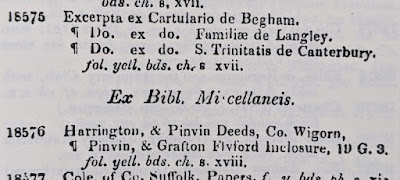 |
| Latin Fragment D.1 (detail) This and the following images reproduced by courtesy of the Cadbury Research Library: Special Collections, University of Birmingham |
I went to Birmingham last week to see the Crivelli exhibition. While in the city, I also went to The Barber Institute (to look at paintings, not manuscripts such as the Liberale da Verona cutting mentioned at the end of this post), and the University Library (because they have a very good set of Folio Society Collectors' Corner catalogues, some of which I have not been able to consult anywhere else), and the Cadbury Research Centre (Special Collections), which holds a large collection of little-known fragments. (And I do mean fragments, not cuttings and leaves).
As usual, in my experience, about 90% of the fragments were unintersting to me (Canon Law, Sermons, Use of Sarum liturgica, etc.), but 9% are interesting and 1% are very interesting. One of the two or three items that comprise the 1% is an unrecorded portion of a copy of Ranulf Higden's Polychronicon Wikipedia], of which a detail is shown above.[1]
The surviving portion consists of just four paper leaves. I was trying to look at a lot of material in about two hours, so I did not take proper measurements, look for watermarks, etc., but I did place a ruler next to the leaves which gives a general sense of scale; they are approximately 30cm tall:
 |
| "18606" printed spine-label |
 |
| "... I have a few fragments of old MSS left. ... Would you care to consider these at HALF PRICE." |
An ambiguous inscription on the box in which the fragments are now housed seems to suggest that they were donated by Hingston Fox to J. Rendel Harris (1852-1941) [Wikipedia], who in turn gave them (along with other manuscripts and fragments) to the University:
Notes
[1] Lists of the known manuscripts can be found in:
- Lynda Dennison and Nicholas Rogers, ‘A Medieval Best-Seller: Some Examples of Decorated Copies of Higden’s Polychronicon,’ The Church and Learning in Late Medieval Society: Studies in Honour of Professor R.B. Dobson, ed. by C. M. Barron & J Stratford, Harlaxton Medieval Studies, 9 (Donnington, 2002), pp. 80-99 (listing 123 copies)
- A.S.G. Edwards & James Freeman, 'Further Manuscripts of Higden’s Polychronicon', Notes and Queries, NS, Bd. 63 (2016), pp. 522-24 (about 17 more copies and 16 MSS with excerpts).
[2] The text of the first three leaves begins a few lines before the start of Book 2, chapter 14 (at "consueveruntOrosius libro primo..."; vol. II, p. 326, line 9 in the Rolls Series edition), and continues to chapter 20 ("... statutum fu[catchword:]it inter illos" p. 386, lines 9-10 of the edition). The last leaf contains Book 6, parts of chapters 23-24 ("monachum primo Londoniensem episcopum ... non ex ambitione et [nummi]" p. 162 line 7 p. 182 line 10 of the edition).








You may want to check Trevor Smith's 2017 University of Leeds PhD dissertation, which includes a list of all the known English chronicles for the reign of Edward III and of all the manuscripts (including many of which Smith first identified). https://etheses.whiterose.ac.uk/20822/
ReplyDelete